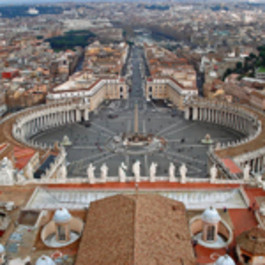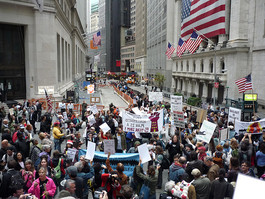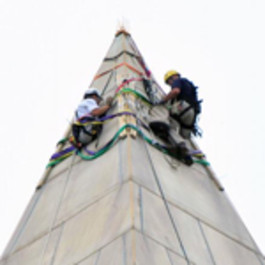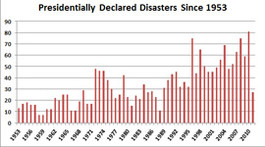Let me be quick to paraphrase the words of Amos, “I am not a prophet, nor the son of a prophet” (see Amos 7:14). Truth is, living in the 24/7 news cycle of these tumultuous times, it doesn’t require mega-doses of prescience to make the following prediction here in this Fourth Watch blog. The unraveling this week of the much-heralded (last week) “resolution” to the European Union’s intractable Greece crisis has given new meaning to the “tragedy-comedy” genres of theater the ancient Greeks gave to the world. Greek prime minister George Papandreou announced on Monday a national referendum next year to decide whether Greece would accept last week’s eleventh hour EU bail-out offer. European leaders were stunned. One Irish commentator (perhaps reflecting Ireland’s own precarious financial survival) observed: “The date of that [referendum] vote is as unclear as any intricate political calculations behind Prime Minister Papandreou’s decision to call it, or even whether he informed the Franco-German neo-axis powers before announcing it. Nor is it obvious what the precise implications for Europe might be, other than perfectly hideous. Chaotic hardly seems an adequate adjective. The Greeks have unleashed pandemonium, and if there is any hope remaining in Pandora’s box this time around, you’d want the Hubble Telescope to locate it.” (http://www.belfasttelegraph.co.uk/opinion/columnists/this-is-no-return-to-ancient-greek-democracy-16071942.html#ixzz1cYe9vpXV) In all fairness, the EU-Greece drama is matched only by our own government’s political theater played out in Washington’s “tragic comedy” efforts to stanch America’s financial hemorrhaging. Truth is—the entire world teeters on the razor edge of economic collapse. And that is the Fourth Watch prediction of this blog—that the “new normal” for our national and global economy will be accelerating uncertainty that will terminate in irreversible ruin, the collapse of our civilization. I.e., the second law of thermodynamics will prove true economically—we will move from a state of equilibrium to an irreversible state of entropy and collapse. But such a prediction is hardly rocket science. So why make it? Because I fear for my church. I fear that the indomitable pluck and inbred optimism of the American spirit will temper our apocalyptic awareness and shackle our Adventist sensitivities. I fear that like the five foolish virgins of Jesus’ parable we will drowsily murmur that there is surely more time that must pass before our “second advent” hopes need awaken. I fear the following prediction: “Transgression has almost reached its limit. Confusion fills the world, and a great terror is soon to come upon human beings. The end is very near. We who know the truth should be preparing for what is soon to break upon the world as an overwhelming surprise [read “sudden”]. . . . Are we as a people asleep? Oh, if the young men and young women in our institutions [read “Andrews University”] . . . could only discern the signs of the times, what a change would be seen in them!” (8T 28, emphasis supplied) Then what shall we do? The soon-coming Christ makes this invitation: “‘Listen! I am standing at the door, knocking; if you hear my voice and open the door, I will come in to you and eat with you, and you with me’” (Revelation 3:20 NRSV). Now is the most opportune time we have left to “share a meal as friends” (NLT) with our Savior. Now is the only time we have left to make a personal friendship with God our highest priority. (How? Click here and I’ll share the answer with you) Put it off, and like the EU and Greece, I fear it will become the “tragic comedy” of too little, too late.
Pastors' Blog
By Pioneer Pastors

On Monday Rome issued a bold 18-page response to and proposal for the burgeoning financial crisis engulfing the world. According to the Reuter news agency it calls “for sweeping reforms of the world economy and the creation of an ethical, global authority to regulate financial markets as demonstrations against corporate greed continued to spring up in major cities across the globe” (uk.reutres.com/article/2011/10/24/Vatican-economy-idUKL5E7LO1LS20111024). While a Vatican spokesman clarified that the document is not an expression of the pope or the papal magisterium and does not carry the weight of church dogma, it nevertheless bears “an authoritative note” from the Pontifical Council for Justice and Peace (http://www.newsmax.com/EdwardPentin/Vatican-Global-Finance-Plan/2011/10/25/id/415693). I have reviewed the document, posted at the official Vatican news website (www.zenit.com). It is laudable that Rome raises her voice over the plight of the economically disenfranchised. In doing so she sympathizes with the populist Occupy Wall Street movement that has gone global over the last few weeks. And it certainly is within the purview of a church body to call the world to economic equity. But central to this Vatican proposal is the formation of a “supranational authority” (also called the “world Authority” in the document) to guide and lead the world toward a more equitable banking and economic policy and practice. And it is precisely the language of a “universal jurisdiction” and a “central world bank” that concerns me and should concern others who are watching for the apocalyptic endgame. The document proposes that the United Nations become the initial vehicle for economic reform, “on the way to creating a world political Authority.” Who or what that world Authority is beyond the U.N. is not identified in the proposal. But for students of Revelation 13, the prediction that at the end of time there will be a resurgence of the geo-religio-political power of the Dark Ages gives cause for pause. “And all the world marveled and followed the beast” (Revelation 13:3). Those who suggest the Vatican’s proposal is simply an economic policy recommendation need to reread the document: “In this process, the primacy of the spiritual and of ethics needs to be restored and, with them, the primacy of politics—which is responsible for the common good—over the economy and finance” (Zenit, emphasis supplied). So whose definition of “spiritual” do you suppose Rome envisions for the world, whose “primacy” does she seek to restore? Cardinal Peter K. A. Turkson concludes this document, surprisingly for apocalyptic watchers, with a discussion of Babel! “The image of the Tower of Babel also warns us that we must avoid a ‘unity’ that is only apparent, where selfishness and divisions endure because the foundations of the society are not stable. In both cases, Babel is the image of what peoples and individuals can become when they do not recognize their intrinsic transcendent dignity and brotherhood” (ibid). But apocalyptic watchers know that Babel is in fact the image of “confusion,” of the human attempt to replace God with itself, of Babylon’s fateful amalgamation of pagan self-worship with a vestige of divine truth. It is that Babylon that Revelation warns will rule the world in the end. And for that reason we who live in the Fourth Watch of history should hardly be surprised with the Vatican’s offer to the world this week. As Jesus warned, “Let those who have ears hear” (Revelation 2:7, 11, 17, 19; 3:6, 13, 22).

“Here’s a Fourth Watch story for you,” emailed one of the readers of this blog. And I agree. Early Sunday morning, June 25, 2006, Corporal Gilad Shalit, a nineteen year old soldier with the Israel Defense Forces, was kidnapped by Hamas militants on the Israeli side of its border with Gaza. Abducted back into Gaza, Corporal Shalit became the rallying cry of a nation caught between two clashing ideals: never negotiate with terrorists versus never abandon one of your own. Hamas refused International Red Cross requests to visit Shalit on grounds that it would reveal the captured soldier’s whereabouts. Over the five years of his captivity “Free Shalit” rallies across Israel increased pressure on the Israeli government to achieve his release. The news this week that Hamas had agreed to return Corporal Shalit was met with jubilation by Israelis . . . until the negotiated terms of the release were reported. And suddenly the country was divided. How much is one Israeli soldier worth? 1027 convicted Palestinian prisoners? Listen to one Israeli family’s reaction: “Embittered father Zeev Rapp, 66, sat at home and watched the television in disgust. In 1992, Amrin [one of the released Palestinian prisoners] stabbed Rapp’s daughter Helena, 15, in the heart as she was on her way to school. Now, he was . . . walking free with other smiling prisoners, flashing victory signs and kissing the ground. ‘We feel as though our daughter has been murdered all over again’” (South Bend Tribune 10-19-11). And Shalit? Egyptian television released the first images of the now freed corporal, “pale, gaunt . . . in a dark baseball cap, exiting a car in Egypt, which mediated the handover” (ibid). Ecstasy for his family, mourning for another. How much is one Israeli soldier worth? So how much is one sinner worth—Israeli, Palestinian, American, Afghan, Chinese, Sudanese, Mexican, Indian? How many earth children would God be willing to pardon and release for the exchange of His own Son? I realize the metaphor shifts and collapses the moment we introduce Calvary. But you do have to wonder, don’t you, the prisoner exchange that effected our salvation and release? The psalmist struggled over the dilemma: “No one can redeem the life of another or give to God a ransom for them—the ransom for a life is costly, no payment is ever enough” (Psalm 49:7, 8 NIV). How true. How could any of us possibly provide the ransom for just one sinner even in a thousand lifetimes? And yet the stunning announcement of the Good News is that God found the ransom for this rebel race within His own circle, within Himself. “And the LORD has laid on Him the iniquity of us all” (Isaiah 53:6 NKJV). That’s not 1027 to one. Nor is it 7 billion to one. It’s every human being in the history of this planet to One—“‘The Son of Man came to give His life a ransom for many’” (Mark 10:45). Very many! Because God has been into prisoner exchanges for a long time, hasn’t He? Take that Friday morning the rabble clamored for a murderer in exchange for the Innocent—and got Barabbas instead of Jesus of Nazareth. But whether it’s one for One, or billions for One, the numbers really don’t matter, do they? Love’s radical prisoner exchange is beyond comprehension.

Let’s talk health and the end of the world for a moment. You probably would have to be a man to have paid much attention to the two recent headlines that have challenged the medical community. Headline #1—a government panel of physicians and researchers released their findings last week with the recommendation that the simple P.S.A. (prostate specific antigen) blood test for prostate cancer (a cancer diagnosed in one of every six American men) no longer be prescribed. “The ‘vast majority’ of men treated for PSA-detected tumors do not prolong their lives, yet that treatment subjects them to ‘significant harms,’ including urinary, sexual, and bowel problems, the U.S. Preventive Services Task Force said in a draft of updated recommendations.” (http://www.philly.com/philly/health_and_science/131566278.html?cmpid=15585797) But loud protests from the medical establishment are evidence enough that the health community is divided over this proscribed protocol. So whom shall we believe? Headline #2—this Wednesday the Journal of the American Medical Association published a national study concluding that Vitamin E and selenium (heretofore recommended by some as a defense against prostate cancer) are ineffective in such prevention. In fact the study concluded that men who take Vitamin E actually have a small increased risk for prostate cancer (17%) over those who do not take the vitamin megadoses! The truth about most of life is that “we see through a glass darkly” (I Corinthians 13:12). What once looked so certain and convincing so often turns out to be a mirage, a misunderstanding, a misreading, or simply a mistake. Well-meaning though we are, nevertheless wrong we can turn out to be. Is it that way with the things of God, too? Yes. And No. Yes, because my finite comprehension is precisely that—finite. And when I turn my questionings to the infinite God who created me, it isn’t difficult for me to misread or misunderstand his response on any level. Job was right: “Can you fathom the mysteries of God? Can you probe the limits of the Almighty?” (Job 11:7 NIV). Are there then no certainties, no verities, no unequivocal divine revelations we as mortals can cling to? But of course! The compelling biblical truth that the God who created us is the God who redeemed us through his own incarnated life and death and resurrection is sure. So is its corollary revelation that “this same Jesus” (Acts 1:11) will return to this earth in a spectacular rescue of his friends at the disintegrating end of human history as we know it. But what about the crescendo of voices declaring that his return and earth’s end are much nearer than we first thought? How reliable are those prognostications? The fact is that even if it were only the economy we were analyzing, warnings from across the political and philosophical spectrum are mounting. The disturbingly obvious fact that no bright mind has found the cure to our global economic plight is telling. A century ago came this analysis: “There are not many, even among educators and statesmen, who comprehend the causes that underlie the present state of society. . . . They are struggling in vain to place business operations on a more secure basis” (9T 13, emphasis supplied). That last line is the recurring theme of our daily news, isn’t it? My personal conviction is that “soon” is no longer an inappropriate adverb to add to the declaration, “Jesus is coming”—“soon.” In fact I believe that his soon return is one of the unshakeable verities that this generation can take to the prophetic bank. “I will come again” (John 14:3) aligns now as never before with “Behold, I am coming quickly” (Revelation 22:12). And that alignment is precisely why you and I can live with an optimistic certainty absent from the medical headlines lately.

Here in the Fourth Watch blog we examine current trends in this nation or the world that I believe are harbingers of earth’s darkest hour (what the ancient Romans called the fourth watch) just before the sunrise of Christ’s return. And while these observations and analyses reflect my personal convictions, I am amazed at the ascendency of voices—secular as well as religious—that are warning of what lies ahead for our civilization. Take for example the seemingly isolated street protests against Wall Street, that for three weeks now occupied Zuccotti Park in the financial district of New York, railing against corporate greed and economic decline, and blaming US financial institutions and Wall Street for the resultant unemployment. Hundreds have been arrested. But thanks to Twitter and social media sites, the New York protests are now spreading to other cities in the nation. Students now threaten walk-outs from classes in sympathy with these protests. (Though less violent, these homeland demonstrations are not unlike the radical street protests in Athens, as Greeks have turned with vengeance on their government and the European Union for their own financial meltdown—and what now appears to be certain national bankruptcy.) How could an isolated street protest burgeon into a national movement? Here’s CNN.com’s assessment: “Occupy Wall Street is a leaderless movement made up largely of twentysomethings upset with the economy, the Afghanistan war, the environment, and the state of America and the world in general. In less than three weeks, the movement has become a magnet for countless disaffected Americans at a time when an overwhelming majority of U.S. adults say the country is on the wrong track” (http://www.cnn.com/2011/10/05/politics/occupy-wall-street/). But what could morph the Occupy Wall Street protests into an apocalyptic game-changer is the announcement that labor unions are joining the movement. Responding to Twitter calls from Occupy Boston (a sister movement to the New York protests), the Massachusetts Nurses Association is joining the rally. In New York so are the Amalgamated Transit Union, the Transport Workers Union, and the United Federation of Teachers union among others. Is it possible that a nationally diminished labor movement could find new life and impetus in all of this? How innocuous are labor unions in a Fourth Watch scenario? In a terse exposé of capitalist excesses, the Bible declares: “Now listen, you rich people, weep and wail because of the misery that is coming upon you. . . . Your gold and silver are corroded. . . . You have hoarded wealth in the last days. Look! The wages you failed to pay the workmen who mowed your fields are crying out against you. The cries of the harvesters have reached the ears of the Lord Almighty. You have lived on earth in luxury and self-indulgence. You have fattened yourselves in the day of slaughter. . . . Be patient, then, brothers and sisters, until the Lord's coming. . . . because the Lord's coming is near” (James 5:1-8). A day of reckoning is coming for the barons and minions of Wall Street who have made their billions at the expense of the paltry savings and investments of a once unsuspecting public. But could a sympathetic labor movement backlash into a prophetic paradigm shift? These words were in a letter written in 1904: “The trade unions will be the cause of the most terrible violence that has ever been seen among human beings” (Letter 99, 1904). Main street, Wall Street, the street protests may not be so innocuous after all. My point: the headlines we now live through are not inconsequential to a Fourth Watch mindset, are they? NOW is the most opportune time you and I may ever have to freely share the everlasting gospel of Christ with people who need him—family members, friends, colleagues. NOW is the church’s opportunity to seize the moment, rise up and in the panoply of the Spirit’s infilling and hurry to a final civilization with the news of Jesus’ soon return. Our friend Ron Clouzet’s satellite series, “Prophecies Decoded,” to the continent couldn’t be timelier (join us this evening at 7:20). Let him, let her who has ears hear. For the rumble we hear may be the tread of an approaching God.

If you’re afraid of heights, don’t read any further. But can you imagine people actually doing this for a living? The engineering firm—Wiss (that’s not “woos”), Janey, Elostner Associates Inc., from Northbook, Illinois—has been hired by the National Park Service to provide an inch-by-inch inspection of the Washington Monument in our nation’s capital. How much damage did this national treasure sustain in the recent earthquake that shook Virginia and the east coast? To find out on Tuesday, two of the firm’s “difficult access team” members—under the watchful eye of Brandon Latham, a ranger from Denali (Mt McKinley) National Park in Alaska, himself an expert at rappelling—crawled out a hatch (unopened for the past 11 years) and climbed within feet of the 555-foot-high pyramid tip of the monument to begin setting up a rope system and equipment for “daredevil” inspection. But lightning in the area drove them back inside. Hanging 555 feet above the concrete mall below with lightning striking nearby—it’s the grist of nightmares for some of us land lubbers! But what’s the Washington Monument in comparison to the teetering edge from which the global economy may yet plunge? Having just returned from Paris where the euro still reigns, I was surprised that Bloomberg’s business editors this week challenged the brave face that Germany and France are putting on regarding Greece’s financial meltdown: “They’re all in denial. Almost no one believes Greece is solvent, not with an economy—and tax receipts—shrinking and debt ballooning to 180 percent of gross domestic product, a burden that no amount of belt-tightening will make bearable. The question now is whether Europe can arrange a controlled and orderly default, or will allow a Greek bankruptcy that is chaotic and destructive to the global economy.” (http://www.bloomberg.com/news/2011-09-28/road-map-to-prepackaged-orderly-default-that-keeps-greece-in-euro-view.html) We can be glad God isn’t afraid of heights! “‘Fear not, for I am with you; be not dismayed, for I am your God. I will strengthen you, yes, I will help you, I will uphold you with My righteous right hand’” (Isaiah 41:10). Hanging on for dear life to a fraying rope, or holding on for dear life to His right hand—the choice is a no-brainer. And yet, by the billions there are human beings who know their ropes but not His hand. We must reach them now. Which is why each year on Alumni Sabbath we receive a special offering for Student Missions at Andrews University and Pioneer Memorial Church. Last March more than 285 responded to an appeal to “go into all the world” on behalf of Christ our Lord—to find those who have yet to find God’s hand and know His heart. Today would you please help us help these students help Christ reach this world in this generation? The Student Missions offering envelope in today’s worship bulletin is our opportunity to defy the heights from which this world will yet fall—and to send forth our young and our best on mission for the soon-coming Jesus. God occupies the heights—we have no reason to fear—and every reason to act now on His and their behalf. Thank you.

“Trim the Fat, Roast the PIIGS,” yelled one headline. “Is Europe Going to the PIIGS?” chided another. For those who aren’t following the European Union’s debt crisis, PIIGS is an acronym for Portugal, Ireland, Italy, Greece and Spain—five European nations on the brink of bankruptcy. In fact, some are estimating that Greece’s bankruptcy is now 98% certain. And the drama this week has centered on Chancellor Merkel of Germany and French president Sarkozy’s huddle with Greek prime minister Papandreou. Will the economic powerhouses of Europe be able to pull the rabbit out of the hat, or will Greece’s financial collapse drag Europe into its swirling vortex? (To insure $10 million of Greek debt now costs $5.8 million! http://seekingalpha.com/article/293251-eurozone-trim-the-fat-roast-the-piigs) Perhaps Nebuchadnezzar’s ancient dream (Daniel 2) about a towering metallic image deserves another look. Are its iron and clay toes—the nations that grew out of the collapse of the Roman Empire—a prophetic warning that even an economic union like the European Union is doomed to fail? “Just as you saw the iron mixed with baked clay, so the people will be a mixture and not remain united, any more than iron mixes with clay” (v 43, emphasis supplied). And how will the United States—itself teetering on the economic edge—weather this hemorrhaging crisis? Thinkers the world over are warily endeavoring to decipher these unusual times. The gyrating global stock markets are simply empirical indicators of mounting apprehension and perplexity. Nobody knows. Emphasis on nobody. Thus the future of earth. What a made-to-fit moment this is for the “Prophecies Decoded” series that begins on September 30—seen coast to coast on satellite, and “live” here at Andrews University. And wouldn’t you know it—the opening lecture comes straight out of Daniel 2’s provocative prophecy. My friend, Dr. Ron Couzet, is the presenter. And he is as trustworthy and credible a voice I know to speak to the urgency of these times. That’s why I’d like to earnestly invite you to take advantage of this prophetic lecture series, by inviting friends, colleagues, neighbors you know who would benefit from a careful, biblical examination of the prophecies that speak to our age. We’ll be offering a big-screen live link to Nashville, Tennessee, where Ron Clouzet will be speaking—Friday evening, 7:20, September 30—that’s when it begins. Pick up a handful of the color brochures at Pioneer to give your friends. Have them go online to www.propheciesdecoded.com and watch the series trailer for a themselves. Call them up and offer them a ride. The point is—when you’re living in the toes of earth’s history—there is something greater than PIIGS to motivate your life. And that something is the Someone who is coming soon. So pass the word, will you? The PIIGS, Europe, the U.S., you and I—we’re all living on the edge. It’s time to believe. “‘The great God has shown the king what will take place in the future. The dream is true and its interpretation is trustworthy’” (Daniel 2:45).

This Tuesday I sat with rapt attention, along with the rest of the student body (you could have heard a pin drop), as Stanley Praimnath recounted his harrowing survival on the morning of September 11, 2001. An associate vice-president with Fuji Bank (which occupied floors 78 through 81 in Twin Towers #2), Praimnath was on the phone in his 81st floor office, when he happened to glance across the space and out a far window. For a split second, he watched a United Airlines jet (“I saw the giant U on the tail of the plane”) hurling at eye level (“I could hear the engines accelerating”) directly toward his office space. In that slow motion instant, Praimnath threw the phone, instinctively diving under a nearby desk at the moment of impact. His world exploded. Choking jet fuel, thick dust, darkness, the floor above him collapsed onto the only desk that withstood its weight—the one he was under. Praimnath’s horrendous ordeal to survive had begun. On this tenth anniversary as the nation pauses to remember, what is it we will collectively recall? We remember the 2,976 victims of this four-site tragedy—the innocent victims in the air and on the ground, the heroic first responders in New York City. We also remember the 3,000 people who, like Stanley Praimnath, survived the infernos but who bear the scars and still relive the nightmare a decade later. We remember all the families who have had to go on surviving without the one they loved about their table. We remember people. We remember the 236 foreigners, citizens of other lands, who perished on September 11. And while we know little about the perpetrators of this crime against humanity, we can only imagine the pain of those families, as well. The truth is September 11, 2001, broke not only ten thousand hearts, but deeply wounded the heart of the Father of humanity. “In all their affliction, He [is] afflicted” (Isaiah 63:9). Ideologies, theologies, geo-politics aside, the greatest grief over the human plight still breaks the strongest heart of all, doesn’t it? Christian, Muslim, Jew, pagan—the labels we conveniently affix are in some visceral sense immaterial to him, are they not? Ten years later the statistics keep exponentially mounting. This year relief aid workers estimate that one million men, women and children will die from starvation—in Somalia alone! Nationality and religion and ideology pale before so immense a human loss, so far away from our evening dinner tables. But if not even “two sparrows . . . will fall to the ground outside your Father’s care” (Matthew 10:29), to quote the Master, then how much more do the 2,976 of September 11 and the one million of 2011 matter to him? This weekend it is right that we remember. But let us not take refuge in the remembering. Let us instead transform our memories into proactive, specific responses to the immense human needs all around us. Helping one child in Benton Harbor’s inner city—by joining the street ministry teams at 3 PM today, or by marking your gift in an offering envelope “Benton Harbor”—can turn remembrance into life-changing assistance. Somalia? You’ll never go there. But Benton Harbor—we can make a difference right now here at home. Then their deaths were not in vain. Then September 11’s legacy can yet be one of healing and hope. Stanley Praimnath survived because a stranger with a flashlight came seeking. How many other survivors could there be, if you and I would do the same?

The old American folk song sings it well, doesn’t it? Irene goodnight, Irene goodnight Goodnight Irene, goodnight Irene I’ll see you in my dreams You cause me to weep, you cause me to mourn You cause me to leave my home But the very last words I heard her say Was “Please sing me one more song” Irene goodnight, Irene goodnight Goodnight Irene, goodnight Irene I’ll see you in my dreams But nobody up and down the eastern seaboard is in any mood to sing these words, as the massive clean-up for Hurricane Irene’s devastation continues. “You cause me to weep, you cause me to mourn, you cause me to leave my home” pretty much sums it up in the aftermath of this storm—remembered more for her rains and floods rather than for her winds. Over forty dead, property damages predicted to exceed $7 billion, Irene now ranks in the top ten most expensive disasters in this country’s history. But what caught my eye this week was the announcement that this marks the sixty-sixth disaster that FEMA (the Federal Emergency Management Agency) has faced in 2011. And the monies are running low, with only $900 million left in FEMA’s disaster aid funding. So here’s a question for your own brooding: Could an escalation in natural disasters drain our national economy? I.e., is it possible that a spike in costly disasters could someday (I’m not suggesting today) actually deplete government resources, drain private reserves and diminish our collective ability to respond to nature’s emergencies? How many more hurricanes or droughts (Texas was praying for the rain of that hurricane to veer westward to relieve their own withering disaster) or earthquakes would it take to “break the bank” in the United States? (Look at Japan with a single earthquake and tsunami this year, as she still struggles to gain her economic footing.) The US News and World Report website reported this week: “To date, according to the Federal Emergency Management Agency’s website, President Obama has declared 24 emergencies and 66 major disaster declarations in 2011. So, also including those for fire management assistance, President Obama has made 181 FEMA declarations this year. That figure easily eclipses the previous record of 157 overall annual declarations set by Bill Clinton in 1996.” And the year isn’t even over. (http://www.usnews.com/news/articles/2011/08/30/12-states-with-the-most-disaster-declarations-in-2011?PageNr=1) “Good night, Irene.” But could it be “Good night, America” one of these days? Two thousand years ago, Christ made this terse prediction of global conditions that would occupy the headlines on the eve of his return: “On the earth, nations will be in anguish and perplexity at the roaring and tossing of the sea. Men will faint from terror, apprehensive of what is coming on the world, for the heavenly bodies will be shaken. At that time they will see the Son of Man coming in a cloud with power and great glory” (Luke 21:25-27). So shall we panic? Not at all. But we really do need to quit living life as though it were “business as usual.” The “usual” has long gone, and the “unusual” is now our new “usual.” So what if we lived with the quiet confidence Christ’s next sentence offers: “When these things begin to take place, stand up and lift up your heads, because your redemption is drawing near” (v 28). Is Jesus suggesting a quiet confidence in his prediction? No, but implicit in his command is an abiding confidence in the One who is to return. That’s why our new series, “The Last Word: The Fourth Gospel for a Final Generation,” is front and center this new season—because reliving the story of Jesus can revive our faith in Jesus. Not faith in the headlines of earth’s “fourth watch”—but rather faith in the One who has promised that after the “Good night” will come the very “Good morning.” No wonder we can live the “fourth watch” with our heads up!

Facebookers on the west coast have had fun, good-naturedly chiding their east coast cousins. “A 5.8 magnitude earthquake—and you’re hyperventilating?” After all, the 7.0+ magnitude quakes Californians have lived with for decades do make the temblor in Virginia this week seem a bit “wimpy.” But a quake is a quake. And the nervous chatter of “survivors” in the nation’s capital made for headline grist. Not to be outdone, The South Bend Tribune carried the testimonies of those in Michiana who felt the earth move (ever so slightly) “way out here.” All the while Hurricane Irene is barreling up the Atlantic with the usual late summer gusto of another tropical storm turned destructive. (Remember school beginning six years ago on the heels of Hurricane Katrina?) And the folks in Texas? They were praying hard that the storm would head their way, since their state is now gripped in the most ravaging drought in its long history. Ah, the weather and quakes—Mother Nature keeps changing the subject, doesn’t she? And as for the Arab Spring—nobody’s sure now where that “spring” is headed. Egypt struggles with her new lease on democracy. Syria’s lethal crackdown only worsens. Yemen is off the radar screen. Libya now is front and center—and nobody knows where Gadhafi might turn up or how that awkward revolution might turn out. As once again Israel and the Palestinians go at it—rocket for rocket, tit for tat. Some spring that was! Anybody want to discuss the global economy—Europe, the U.S., China? I didn’t think so. Because, truth be told, nobody knows. Period. Listen, do you suppose the entire planet—read, the human race—feels these mounting seismic tremblings? Could it be that all of us—God believers or not—with awkward uncertainty and mounting dis-ease stare into the unknown ahead of us? In 1921 W. J. Yeats composed his poem, “The Second Coming”: Things fall apart; the centre cannot hold; Mere anarchy is loosed upon the world, The blood-dimmed tide is loosed, and everywhere The ceremony of innocence is drowned; The best lack all conviction, while the worst Are full of passionate intensity. “Full of passionate intensity”—the moniker of “this generation.” Then perhaps we all—God believers or not—could profit from a reflective brooding through an ancient gospel. “The Last Word: The Fourth Gospel for a Final Generation.” Because maybe the “Peace I leave with you” promise tucked near the end of the Jesus narrative (John 14:27) is earth’s most sought gift of all. And so the journey commences right here, right now. Never mind the earth beneath your feet—stay on course until the Gift is in your heart.
- ‹ previous
- 44 of 64
- next ›
